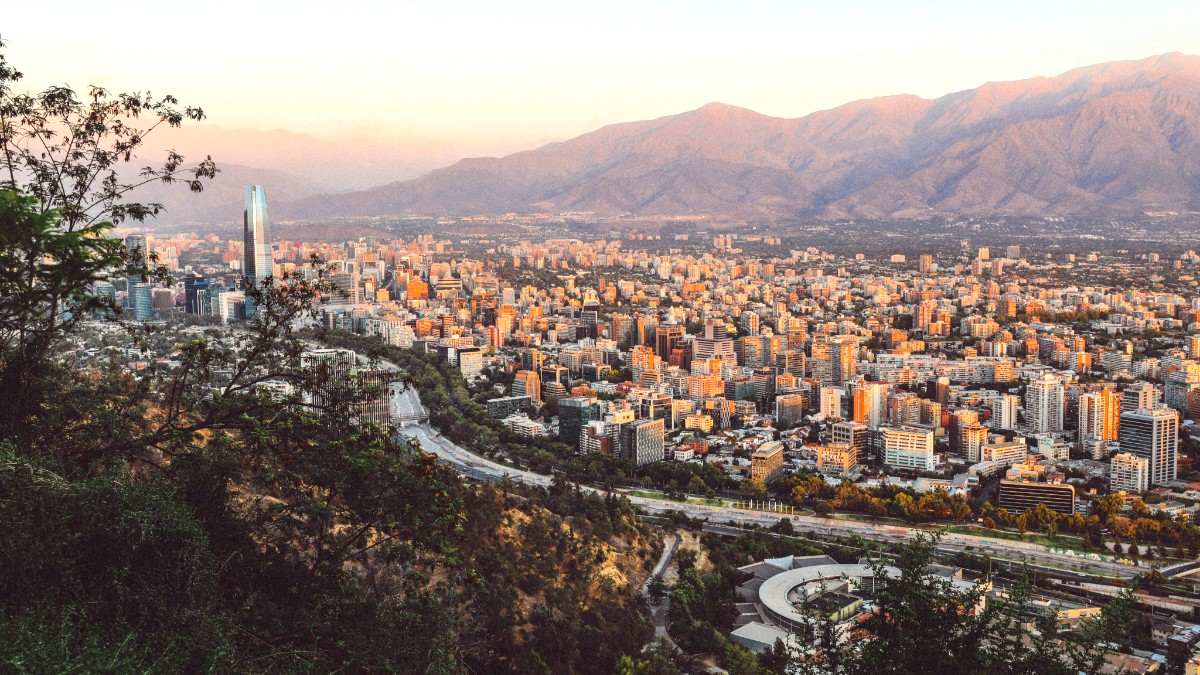
Chile
Santiago presents itself as a city of contrasts. Busy financial districts like Las Condes reflect its economic power, while the cobblestone streets of Lastarria whisper tales of artistic heritage. Lush parks offer respite from the urban pulse, and bustling markets invite you to taste local life. A trip to Santiago means discovering a city that honors its past while looking towards the future.
Santiago blends modern skyscrapers with charming historic districts. From the bustling energy of downtown to the tranquil paths of its parks, the city balances its past with its present. Discover a metropolis that celebrates its heritage while embracing contemporary life.
Explore financial districts like Las Condes, known for its tall buildings, then find artistic inspiration in Barrio Lastarria's cobblestone streets. Each neighborhood tells a different story, making Santiago a truly destination.
The city itself developed along the Mapocho River, which flows from the Andes through the urban core. Historically, the river provided water and a natural divider. Today, it is channeled and flanked by parks and avenues. Its path influences the layout of some neighborhoods and creates green corridors for relaxation.
Santiago's elevation is approximately 520 meters (1,700 feet) above sea level. This moderate altitude means most visitors do not experience altitude sickness.
Dramatic eastern boundary, visible from the city, direct access to ski resorts and hiking.
Western mountain range, shapes climate, short drive to Pacific coast.
Flows through city, historical significance, lined with parks today.
Fertile basin supporting agriculture, home to famous wine regions.
Approx. 520m (1,700ft) above sea level, generally no altitude sickness.
The fertile Central Valley surrounding Santiago supports extensive agriculture, especially viticulture. Chile’s famous wine regions, like the Maipo Valley, lie just outside the city's metropolitan area, benefiting from the region's climate and mountain-fed irrigation. This geographical advantage makes day trips to world-class vineyards simple.
Urban expansion has seen Santiago grow significantly across the valley floor. Despite this growth, the distinct natural boundaries of the Andes and the coastal range continue to define the metropolitan area.
The constant presence of the mountains offers a sense of place and guides orientation within the city. You often find a mountain view from many points, grounding your experience.
Santiago's valley setting, cradled by mountains and crossed by a river, creates an unique urban environment where natural beauty is always close by.
The Picunche people, a subgroup of the Mapuche, lived here, cultivating the land and developing complex social structures. Their presence created the groundwork for future settlements, recognizing the valley's agricultural potential and natural resources.
The city's modern history began with Spanish conquistador Pedro de Valdivia. On February 12, 1541, Valdivia formally founded Santiago del Nuevo Extremo (Santiago of New Extremadura) at the foot of Cerro Santa Lucía. This site had strategic advantages: a defensible hill, proximity to the Mapocho River, and fertile land. The Spanish established the city with a classic grid pattern, centered around the Plaza de Armas, a layout still defining the downtown area today.
Colonial rule shaped Santiago for nearly three centuries. It served as the capital of the Captaincy General of Chile, a remote outpost of the Spanish Empire. Churches, civic buildings, and residential structures were built, many experiencing repeated destruction and rebuilding due to earthquakes.
Chile declared independence in 1818. Santiago became the capital of the newly formed republic. The 19th century brought modernization, with infrastructure projects like railways. European influences, from France and England, began to shape architecture and social life.
The 20th century saw rapid urbanization and significant social changes. Santiago's population grew exponentially, becoming Chile's economic and cultural engine. The 1973 military coup and subsequent dictatorship impacted the city, with the Palacio de La Moneda a powerful symbol. After 1990, Santiago experienced continuous growth and modernization.
Today, Santiago provides a living testament to its layered history. Visitors explore its colonial plazas, witness its modern aspirations, and reflect on its past struggles and triumphs. Institutions like the Museum of Memory and Human Rights reflect on the dictatorship era.
Santiago today pulsates with a dynamic energy that captures Chile’s modern spirit while preserving its historical roots. You find a city of approximately six million people in its metropolitan area, making it one of the largest and most influential cities in South America. The urban landscape is a blend of sleek high-rises, charming colonial architecture, and leafy residential streets.
The city's economy is robust, driven by finance, services, and trade. This economic vitality is visible in districts like Las Condes, often dubbed "Sanhattan" for its cluster of skyscrapers and corporate headquarters. This area contrasts sharply with older, traditional neighborhoods.
Culturally, Santiago thrives. Its calendar fills with art exhibitions, theater productions, music concerts, and festivals throughout the year. Museums, ranging from fine arts to pre-Columbian artifacts and human rights, provide insights into Chile’s identity.
For dining, Santiago offers a wide spectrum of options. From traditional Chilean eateries serving hearty "cazuela" to international fine dining. Street food vendors provide quick, flavorful snacks, while bustling markets offer fresh produce and local ingredients. The burgeoning wine scene is also a draw.
Santiago is a city that respects its past. Its colonial architecture and historical sites invite exploration and reflection on its journey through time.
Santiago embraces modernity with its sleek financial districts and thriving contemporary art scene. It constantly evolves, looking towards a future.
A visit to Santiago delivers a rich experience, blending comfort and challenge, familiar elements and new discoveries. It is a launching point for adventures into surrounding natural beauty.